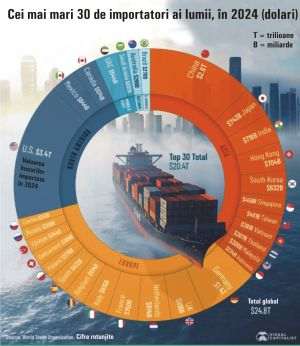The construction sector continues to lead the list of companies entering insolvency in 2023 in our country, despite the support measures taken by the Government for this field of activity, shows the study carried out by Coface Romania and presented yesterday at a press conference.
According to the cited source, the top 3 in terms of the number of companies entered into insolvency are as follows: construction (1,446), retail trade (825) and wholesale trade and distribution (815). The number of insolvencies in the three sectors of activity represents 46% of the total of 6,650 companies that entered insolvency during the past year, a number approximately equal to that of the insolvencies registered in 2022, which was 6,649.
Among the companies that went into insolvency last year, the biggest increase was reported in the construction sector (+6% compared to 2022), a sector that holds 22% of the total number of insolvencies.
Regarding this situation, Bogdan Nichişoiu, Rating (EIC) Manager of Coface Romania, said: "Although in 2023 the infrastructure grew robustly thanks to the projects carried out from European funds, the area of residential construction contracted, and this area represents 50-55% from the entire ecosystem. Even though we see that the prices of building materials have fallen substantially - which is normally good for builders, the distributors of these materials have seen negative profit margins, which has led to liquidity problems and a higher risk of insolvency".
For his part, Tiberiu Chesoi, Head of Claims Department Coface Romania, said: "We notice that in the last 5 years the number of insolvencies has remained relatively constant, and in the last 2 years the half-yearly dynamics is approximately equal to 0%, which shows a stability of the Romanian entrepreneurial environment. (...) However, we see an increase in insolvencies in the textile industry because it is a globalized industry and because of the abandonment of the quota system and the impact caused by the pandemic. Therefore, I would not be surprised if this industry is in first place in terms of insolvencies that will be recorded in the year 2024. It has also increased by 6% compared to 2022 and the number of insolvencies in construction and I think we will see an increase in this number also in 2024, especially in the area of companies dealing with residential construction. (...) At the microeconomic level, a series of challenges are emerging for 2024, such as the decrease in consumption, the high cost of financing, but also the new set of fees and taxes that came into force starting this year, which will put constant pressure on the activity economic. This could lead to extended payment terms to suppliers, increasing the insolvency risk of vulnerable companies".
Of the total number of companies entering insolvency in 2023, companies established before 2016 represent approximately 54%, decreasing from approximately 60% in 2022. Last year, insolvency proceedings were opened for 460 companies with a turnover of over 500,000 euros , up 29% compared to 2022 and 4% compared to 2019. Of these, only 45 companies had a turnover above 5 million euros, which indicates a lower financial and social impact in the economy.
According to the study carried out by Coface Romania, last year 61 preventive bankruptcy procedures were opened, compared to 21 procedures opened in 2022. Among the companies entered into preventive bankruptcy in 2023, 8 companies registered in 2022 a turnover of over 5 million euros and had 1,229 employees.
According to the data provided by the National Bank of Romania, in 2023, 33,790 payment instruments were refused payment, and the total amount refused payment was 2.13 billion lei. Although the quoted source observes an increase both in the value refused (37%) and in the number of incidents (17%) compared to 2022, the values recorded in 2023 are below the values recorded in 2019: -33% in value refused and - 27% as number of incidents.
Regarding the national level distribution of the number of insolvencies, the cited study states that 6 counties alongside Bucharest account for 51% of the total number of open insolvencies in 2023, up by 2 percentage points compared to 2022. The capital leads the ranking with 1,289 insolvencies - up 19% from 2022, followed by the counties of Bihor, Cluj, Timiş, Constanta, Iaşi, Ilfov. Companies from these counties have approximately 46% of the total number of employees of companies that entered insolvency in 2023.
The same counties and Bucharest have a share of 48% of the total number of registrations and 41% of the total number of cancellations.
Most companies were registered (31,091) and deregistered (11,820) in Bucharest.
• 2023 - year of economic stability
The representatives of Coface specified that the evolution of the national economy was marked by lights and shadows during 2023, with a brake on the background of tempering consumption. Against the background of the moderation of demand and the reduction of cost pressures in the segment of hydrocarbons, energy, grains and construction materials, inflation continued its downward trend until 6.61% at the end of 2023, significantly below the level recorded at the beginning of the year (15% ) or the maximum from the fall of the previous year (16.8% in November 2022).
The main macroeconomic vulnerability in 2023 was the perpetuation of double deficits, the fiscal deficit recorded during 2023 being 89.9 billion lei, i.e. 5.68% of GDP, below the initial target of 4.4%. At the same time, the public debt exceeded the threshold of 50% of GDP in 2023.
Alina Popa, Coface Romania Country Manager, said: "The year 2023 can be defined as a year of stability for the business environment, without notable increases in the number of insolvencies. Even if we avoided a recession, after a deceleration of real growth to almost 2 %, compared to 4.1% in 2022, this being one of the best growths in the region, the economic context remains relatively complicated. Large fiscal and trade deficits can generate risks and vulnerabilities for the population and the business environment. Thus, we expect a moderate increase in the number of insolvencies in 2024 caused in particular by the decrease in consumption and the high cost of financing. We are increasing macro and micro economic developments to be able to support companies step by step with solutions adapted to market dynamics".
• Problems in the retail trade area
Returning to the list of insolvencies last year, although for 2024 Coface Romania representatives expect an increase in consumption compared to the increase of only 1.9% recorded last year, it seems that small retailers and the goods distribution sector will continue to face a difficult situation, as it was in 2023 when 1640 firms (825 in retail and 815 in wholesale and distribution) went into insolvency.
The situation is difficult if we take into account that, according to the cited source, retail sales increased by only 2.2%, below the average of 6.2% recorded in 2022, through the lens of the significant deceleration of consumption, although salary dynamics exceeded the average increase of prices in 2023.
Tiberiu Chesoi stated that in 2024 he expects an increase in insolvencies among retail companies, and Bogdan Nichişoiu pointed out: "Obviously, inflation remaining high above the target pursued by the National Bank of Romania will continue to have an effect on the quantity of goods sold. Sales volumes will continue to suffer and, at the moment when we have 6-7% inflation, you cannot see this kind of haemorrhage, pain, consumer crisis. But there are also a series of bandages, especially through the metamorphosis of the consumer, his migration to product segments that are more price-friendly."
Alina Popa concluded: "The basic scenario we have in mind for the year 2024 is soft landing, that is, we expect a return, a normality, not a major syncope in the economy. From the perspective of sectoral developments in Romania, we do not expect to see anything spectacular, statistically unprecedented in recent years. We will probably still have a large number of insolvencies in construction and retail because there are many companies there, but I don't expect it to be anything shocking."
Mrs. Popa's statement is also supported by the x-ray of the business environment at national level drawn up by Coface Romania, which shows that last year 147,026 legal entities were registered - of which 96,839 were SRLs -, down from 2022 when they were registered 152,809 companies. Regarding the number of delisted companies, the trend is favorable, with 71,241 delistings recorded last year, down 3.4% compared to 2022 and 43% compared to 2019 when 101,601 new delistings were reported.













































